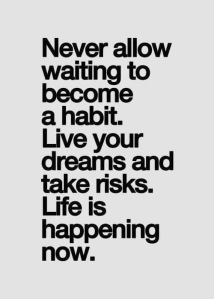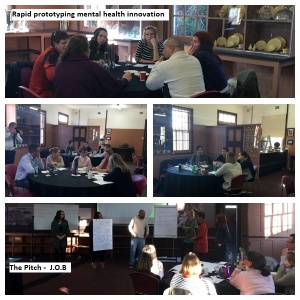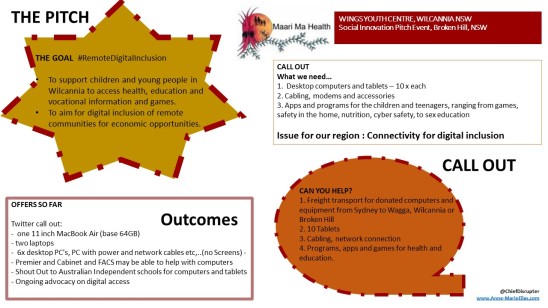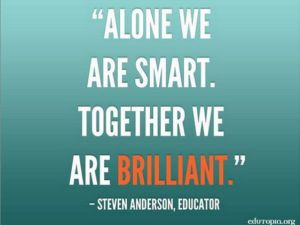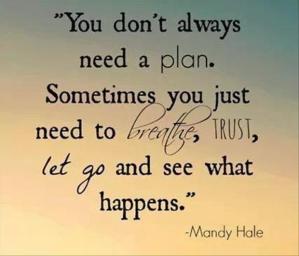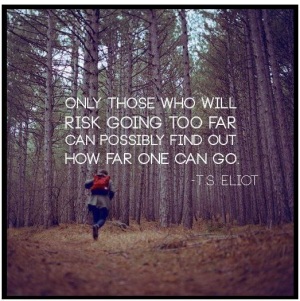“We have enough, and we can do better, so why is it so hard to cause social change? “
I believe it’s because we wade through bureaucracy and stifling processes that take forever to be signed off and implemented. It’s no coincidence that I became fascinated with rapid prototyping, a process I’ve witnessed at Hackathons where participants have 48 hours to identify and develop a prototype and pitch it to an audience. I have seen the outcomes which are astounding, like one of the apps that came out of GovHack created by teenagers called Disaster Master to mitigate risks and provide safety tips and advice on dangerous zones based on past data and predictive analytics. It made me wonder how can we get results like that in other paradigms.I believe that rapid prototyping should be applied to urgent social problems, to systems change and reform, to service design and delivery. Because in our business, people’s lives are at stake and the faster we come up with innovative, adaptable solutions, the better it is for our community and our society.
This journey into disruptive social innovation (the proposed topic of my PhD) has been amazing, I am looking at the areas of design, technology and start up to see if there are methods that can be re-purposed for innovating our responses to social disadvantage. I do this because whatever we are doing is just not cutting it, more and more people are falling through the cracks of suicide, poverty, homelessness, domestic and family violence, unemployment and mental health (Poverty in NSW, Council of Social Services, 2014).
I recently trialled a Social Innovation Pitch event in Broken Hill where we got communities to pitch an idea to an audience of business, government and NGOs. The result was a strong desire to continue running the event including inviting more pitches and community stakeholders. Simply the event created the space for greater collaboration across sectors and connecting people from parallel paradigms. The result, new partnerships and a great deal of good will to help people make things happen for the social good of the community.
Last week I ran an Innovation workshop for Partners in Recovery (complex mental health services) where we went through an immersive process to understand how to innovate and apply innovation in our work. Another way of looking at it is creating the space to unleash the maverick in a group of people who work tirelessly to improve the lives of people with severe and persistent mental illness and complex needs. They are often dealing with the most vulnerable people in the community who have high support needs that cross many agencies health, housing, mental health, and employment. When do we afford ourselves the time to dream and create, to be unencumbered by process and to have a limited time to produce a result, to be bold and not fear failure? I decided to try something – Could we rapid prototype solutions to create better,more innovative and cost effective responses to complex mental health?
So I started to look into rapid prototyping and found Google’s Tom Chi who rapid prototyped Google Glass in one day and Gavin Heaton in Australia who runs a number of innovation projects, hubs, hackathons and workshops.
“Rapid prototyping is a time limited process to develop and idea or solution to a problem, it based on finding the quickest path to a direct experience and on the basis that doing or action is better than thinking.”
Tom Chi
An Australian innovator and disruptor – Gavin Heaton (@servantofchaos) has been doing this through his Disruptor’s Handbook a painless guide on how to “thrive through change”. In a parallel universe, to me Gavin has been delivering innovation to corporates, government and NGOs who have the chutspa to be disrupted. He has been looking at the worlds of business and start up and seeing how they can learn off each other and extending these methods to government and NGOs. He is one of the people behind the recent QantasHackathon and VibeWire (nurturing young change makers and entrepreneurs). Gavin is passionate about the potential of start up and tech to transform the way we think and work in a number of paradigms.
Tom Chi has been trying an experiment (Fast solutions for a brighter future) “to see if the concept of rapid prototyping could be used to reinvent entrepreneurship and possibly all of business.” He applied this concept of “reduce the time to try” to generate new ideas, to four businesses where they reinvented their business, and increased their profits in one day, in what would have been achieved in three months under normal processes (meetings, working groups, processes that take months).
Tom Chi’s experiment was also applied to an impoverished community in Mexico, he took students to run a similar process adapted to a community. The students, in collaboration with the community centre, helped find new sources of employment to subsidize their meagre income. In three hours they developed new streams of business that would treble incomes and filled unmet need in the community. Just by connecting people and finding the opportunities through networks.
Testing the idea of rapid prototyping for mental health support solutions with Partners in Recovery was insightful. The workshop outlined the foundation of disruptive social innovation 1. Flip the problem – don’t try to improve what is, find the gaps in the system 2. User centred – think of the end user 3. Collaborate Widely – leverage the untapped resources and social capital in the community 4.Be bold – embrace failure as learning and improvement. Participants were also asked to think of the features of innovation as resourceful, reflective, creative, collaborative and disruptive. We often think innovation as costly, it doesn’t need to be if you leverage the time, talent and resources of your stakeholders and community.
The teams collaborated for under 2 hours to produce four innovative projects that could change the face of mental health support. They then presented their ideas in the form of a pitch 1. What problem I am trying to solve 2. The solution that will fill that need 3. Ask for what is needed to kick start the project. All pitches were refreshing and innovative, as in any pitch event there could only be one winner and that was J.O.B an employment project that focuses on repackaging skills, ability and aspirations of people with mental health and enrolls employers to support mentoring, career and employment opportunities for people with complex mental health. The project will leverage other community, government, NGO and private sector partnerships in order to provide holistic services to support placements. The project will also leverage the ideas in the other pitches (the veterans and ex-soldiers as trainers) to further develop the prototype.
The feedback was very promising, participants loved the process and found it inspiring, the teams had a skip in their step in realising their capacity to cause social change in such a short time frame. You see their have the expertise and the knowledge, they just needed the opportunity to innovate.
This is proves the power of collaboration and rapid prototyping – the same machine that drives hackathons. When you think about it hackers try to solve a problem through rapid brainstorming, prototyping, testing, refining in 48 hours.
The idea of rapid prototyping and pitching for social change really excites me, these methods work and given the state of emergency on disadvantage in this country, they are desperately needed to transform the way government and NGOs design and deliver services. Let’s rapid prototype for DV, unemployment, inclusion, housing affordability, homelessness and any other social issue that we need responsive, reflective and innovative solutions.
Follow my journey on Twitter @ChiefDisrupter
Anne-Marie is a consultant in innovation for social change, Honorary Associate of the Design Innovation Research Centre and the Centre for Local Government at UTS.
